Each flash has its guide number, GN, for exposure calculation. The GN of a flash is defined at ISO 100 as the product of distance (i.e., flash to subject distance) and aperture:

This means that the product of the flash-to-subject distance and aperture being used is equal to the GN of the flash at ISO 100. Normally, you will see two GN values, one in ft and the other in meter. Therefore, you should choose the right GN in calculations. For example, suppose a flash has a GN 90 in ft and we intend to photograph a subject 20 feet away from the flash. Since 90 = 20×aperture, we have aperture=90/20=4.5. Hence, we should use F4.5 at ISO 100 to take this shot in order to have a correct exposure.
Keep in mind that the GN of a flash is usually given at ISO 100. If a different ISO is being used on your camera, the GN has to be adjusted. Let GN100 be the GN at ISO 100 and GNk be the GN at ISO k. Their relationship can easily be described as

Therefore, if the GN at ISO 100 is 80, the GN at ISO 200 is 113, the GN at ISO 400 is 160, and the GN at ISO 50 is 56.6. With this new GN, one can calculate the aperture from the flash-to-subject distance or calculate the flash-to-subject distance from the selected aperture.
The manuals of many newer flashes have started to provide guide numbers for various focal lengths. This can help more accurately determine the aperture to be used. The following table is taken from Nikon SB-50DX manual. As you can see, a wider angle setting has a smaller GN.
| Focal Length | 14mm | 24mm | 28mm | 35mm | 50mm |
| GN (m/ft) | 12/39 | 18/59 | 20/66 | 22/72 | 26/85 |
Suppose we wish to take a photograph using 28mm and a SB-50DX at ISO 100. If the flash-subject distance is about 8 feet, then the aperture to be used is F8.0 = 66 (28mm's GN) / 8 = 8.25.
After the guide number, the next thing you need to know is the hotshoe and flash contacts. The standard hotshoe is the ISO one. The FZ-10 has a ISO hotshoe (left below). The ISO hotshoe is very simple. It has only one central contact and remaining is for ground contact. However, as long as a manufacturer follows this center contact, they can add any extra contacts for additional features. The middle image below shows a Nikon hotshoe. In addition to the center and ground contacts, there are three more contacts as shown by the three small circular dots. The only exception is Minolta's hotshoe that deviates from the ISO standard (below right). While it is very different from the ISO version, Minolta does sell an adapter that can be used to convert the Minolta hotshoe to the ISO version.

|

|

|
| ISO | Nikon | Minolta |
Since the ISO hotshoe has only one contact, it is not a surprise that the ISO flash foot has only one contact as well. This is shown in the left image below. Hence, if you see a flash whose foot has only one contact, it is an ISO flash, which means there is no addition support other than firing the flash. The middle image below is the flash foot of a Nikon flash, and the right one is a Minolta compatible flash that matches the "strange" Minolta shoe.

|

|

|
| ISO | Nikon | Minolta |
In general, one can use any flash that has a foot compatible with the ISO standard on a ISO hotshoe. The consequence is that all of the addition features provided by that flash will not be supported and that the flash can only be triggered by the camera. Nothing more and nothing less! In other words, even though high end Nikon or Canon flashes can support many powerful features (e.g., TTL - through the lens - metering), when it is mounted to an ISO hotshoe, all of these high end features will become not functional. The flash will become a dumb one that can only be triggered by the camera. Conversely, if one uses an ISO flash on a extended ISO hotshoe, it is also a dumb one because an ISO compatible flash is not supposed to support advanced features.
The FZ-10 has a standard ISO hotshoe as shown in the left image above, and can accept an ISO compatible flash and a flash that is mounted on an ISO compatible adapter. This means the FZ-10 will not do TTL metering with any external flash.
A bounce and swivel flash head is very useful to creative flash photography. The following images, from left to right, show the flash head of a Nikon SB-80DX in direct, bounce and swivel (and bounce) positions, respectively.
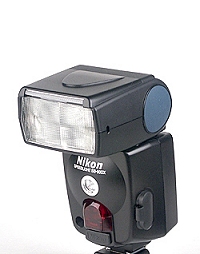
|
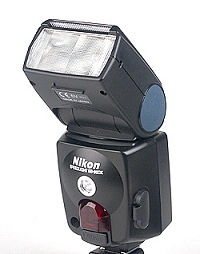
|
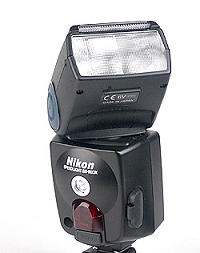
|
Not all flashes have bounce and swivel flash heads. However, many flashes do have bounce flash heads. The left image below shows a Nikon SB22s. Its flash head is fixed; however, its flash tube can be tilted up to vertical position, and down a little. The SB-50DX is another example. Its flash head, similar to that of the SB-80DX, can bounce but cannot swivel. You have to check your flash manual to see the bounce and swivel ranges of the flash head. Some higher end flashes have a built-in bounce card. See the middle image below. One can pull this bounce card out so that when the flash illumination is bounced, the bounce card will create a highlight in the subject's eyes. Some very cheap external flashes may bounce but not swivel. The right image below shows a cheap Sunpak DS20 with its flash head tilted to some degree for bouncing.
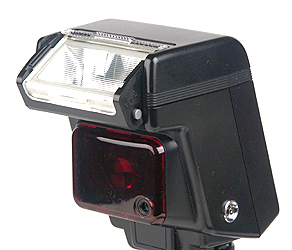
|
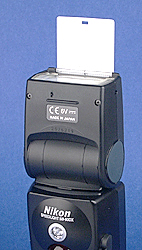
|

|
Most flashes can cover the angle of view of 63 degree that is approximately equal to the angle of view of a 35mm lens (in 35mm film format). With a flash that can only go as wide as 35mm, it will not be able to completely illuminate the scene if a 28mm or wider lens is being used. The following image is an example in which the focal length of the camera lens produces an angle of view wider than the flash angle of coverage. It is clear that the corners are not properly illuminated by the flash light. Some better flashes may be able to go down to 28mm, while newer flashes can cover as wide as 24mm!

To reach a wider coverage, some flashes include a wide flash adapter. A wide flash adapter is a diffuser capable of dispersing the flash light to a wider area. If a wide flash adapter is available, we normally pull it out (below left) and use it to cover a portion or the whole area of the flash tube (below right). With a flash wide adapter, the coverage of a flash can be significantly wider. For example, the Nikon SB-80DX and SB-50DX can go as wide as 14mm.
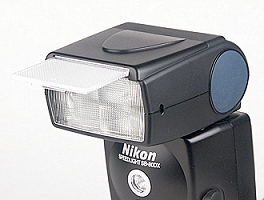
|
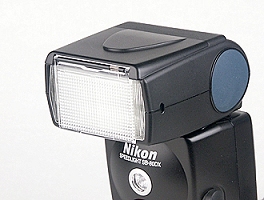
|
The telephoto end is not as problematic as the wide end because if the flash cannot cover a very narrow area that matches a telephoto lens, the flash illumination is wasted. Some flash manufacturers may have telephoto flash adapters available to produce a narrower angle of coverage for telephoto lenses.
It is very important to remember one fact. The maximum flash output is a constant. If the angle of coverage is wider, this constant flash illumination will be distributed to fill a wider view volume, and, hence, cannot reach far enough. On the other hand, if the angle of coverage is narrower, the view volume is also narrower, and flash illumination will be able to reach farther. In summary, a wider (resp., narrower) angle of coverage produces a shallower (resp., deeper) illumination zone.
Based on the discussion in the above section, it would be much better to match the angle of coverage with the angle of view of the lens so that the scene would be illuminated properly. Many flashes have the power zoom capability. With this capability, the camera can communicate the focal length being used to the flash for the flash zoom motor to move the flash head to match the focal length. Unfortunately, the FZ-10 does not communicate the focal length being used to a flash. As a result, either you always set the flash angle of coverage to the widest or manually adjust the zoom setting on the flash. If you choose to use manual zoom setting, you have to be very careful because flashes use 35mm equivalent focal lengths. In other words, you have to convert the FZ-10 focal length to its 35mm equivalent. Here are the conversions for your convenience:
| FZ-10 | 1X | 2X | 3X | 4X | 5X | 6X | 7X | 8X | 9X | 10X | 11X | 12X |
| 35mm | 35mm | 70mm | 105mm | 140mm | 175mm | 210mm | 245mm | 280mm | 315mm | 350mm | 385mm | 420mm |
Since most flashes only support up to around 135mm, if the focal length being is used is larger than maximum supported focal length, then just use the maximum one!
Many flashes have AF assist illuminators. When the scene illumination is low, the camera may activate the AF assist illuminator of the flash to project a dark red pattern as an aid for auto focusing. This illuminator is usually behind a dark red cover on the front panel of a flash. The image below, from upper left and clock-wise, shows the AF assist illuminator of Nikon's SB-80DX, Sunpak PZ5000AF, and Nikon SB22s. The flash in the lower left corner is Sunpak DS20, which has no AF assist illuminator (because the Sunpak DS20 has an ISO contact that is not sufficient for the camera to communicate the activation signal).

Unfortunately, the FZ-10 does not active the AF assist illuminator in low illumination situation because ISO flashes do not support this feature.
Some new flashes have modeling light. Modeling light is used for checking scene illumination and shadow. When it is activated, the flash emits a reduced flash burst repeatedly for a short period of time. In this way, a photographer will be able to check scene illumination and shadow. The image below shows the modeling illuminator button of a Nikon SB-80DX flash.
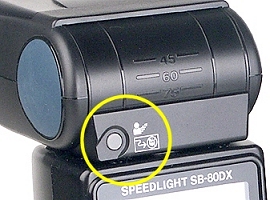
If your flash has a modeling light, you can push the modeling light button and at the same time lightly press the shutter release button to focus. It is likely that the camera can lock on your subjects correctly. The only problem is that this is a two-hand operation, one for the modeling illuminator button and the other for the shutter release button. Some practice may be needed. Note that this is a flash function and is independent of the camera supported features.
Since red-eye reduction is not supported by ISO flashes, the FZ-10 cannot activate this feature even though your flash can do it!